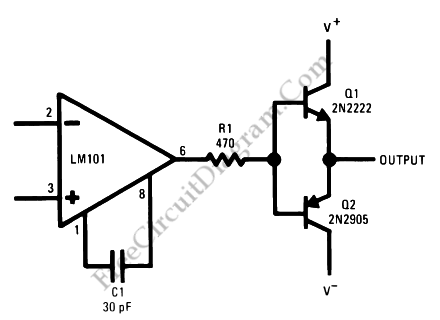Higher Output Current for Op-Amp

Almost all monolithic amplifiers have good loaded output voltage swings, delivering +-10V at 5 mA with +-15V supplies because they use class-B output stages. It would be require much more current from the integrated circuit, for example, to make the output transistor considerably larger. In addition, the rose dissipation could make troublesome thermal gradients on the chip rising as well as excessive package heating in high-temperature applications. Therefore, when large output currents are needed, it’s advisable to use an external buffer. The figure below show a simple way to accomplishing this.

To get the increased current swing, a pair of complementary transistors are used on the output of the LM101. It can be neglected at frequencies below 100 Hz because of the high gain of the amplifier although this circuit does have a dead zone. R1 is used to eliminate parasitic oscillations from the output transistors. In addition, to ensure that the output signal is not coupled back into the amplifier, adequate bypassing should be used on the collectors of the output transistors. Current limiting is not available on this circuit, but it can be added by placing 50ohm resistors in series with the collectors of Q1 and Q2. [Source: National Semiconductor Application Note]